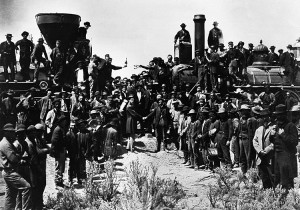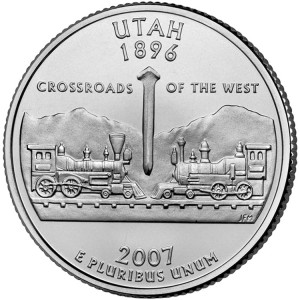Transcontinental Railroad 150
Friday, May 10th, 2019May 10, 2019
On May 10, 1869, 150 years ago today, the world’s first transcontinental railroad was completed in the Rocky Mountain state of Utah. On the momentous occasion, a celebratory final golden spike was driven to complete a transportation network connecting the east and west coasts of the United States. The coast-to-coast railroad revolutionized the settlement and economy of the American West, allowing for the fast and inexpensive transport of passengers and goods. Before the train, transcontinental travel by horse and wagon often took more than four months. By 1876, the rail journey from New York City to San Francisco took just three and a half days.

Railroad workers meet to drive the final spike in the world’s first transcontinental rail line on May 10, 1869, at Promontory, Utah. Credit: Union Pacific Railroad
The transcontinental railroad came together at Promontory, an area of high ground about 66 miles (106 kilometers) northwest of Salt Lake City. In 2019, northern Utah’s “Spike 150” sesquicentennial celebration includes a festival and other activities at Promontory, excursions on vintage trains, exhibitions of historical artifacts and photographs, and tours of recreated workers camps that highlight the immigrants and others responsible for building the railroad.
Beginning about 1830, the first steam locomotives began serving passengers in the United States. By 1850, rail lines served every U.S. state east of the Mississippi River. In 1857, the Baltimore and Ohio Railroad reached from Baltimore, on the East Coast, to St. Louis, just west of the Mississippi.

The Utah state quarter features images that highlight the region’s role in linking the railroad systems of the United States. The transcontinental link was completed by the celebratory driving of a golden spike, which appears at the center of the coin. Credit: U.S. Mint
In the early 1860′s, the U.S. government decided to extend rail lines across the country. The proposed route roughly followed the 42nd parallel from Omaha, Nebraska, to Sacramento, California. Eastern rail lines were to extend westward from Chicago to meet the new railroad at Omaha. The Pacific Railroad Act, passed by Congress in 1862, gave two companies responsibility for building the railroad between Omaha and Sacramento. The Union Pacific was to start laying track westward from Omaha, and the Central Pacific Railroad was to lay track eastward from Sacramento. Congress granted both railroads large tracts of land and millions of dollars in government loans.
Work began on the Central Pacific track in 1863 and, after a slow start, on the Union Pacific track in 1865. The railroads faced the task of crossing the Rocky Mountains and the Sierra Nevada. The Central Pacific hired thousands of Chinese immigrants to work on the railroad. Thousands of European immigrants, hundreds of African Americans, and many former American Civil War soldiers worked on the Union Pacific.
North America was the first continent to have a rail line from coast to coast. The Canadian Pacific Railway completed Canada’s first transcontinental line in 1885. Extensive rail networks were also built in other parts of the world in the late 1800’s and early 1900’s. The railroads opened up vast regions to settlement, farming, and trade.


